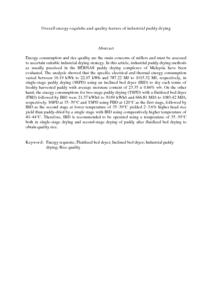Citation
Sarker, Md. Sazzat Hossain and Ibrahim, Mohd Nordin and Abdul Aziz, Norashikin and Punan, Mohd Salleh
(2014)
Overall energy requisite and quality feature of industrial paddy drying.
Drying Technology, 33 (11).
pp. 1360-1368.
ISSN 0737-3937; ESSN: 1532-2300
Abstract
Energy consumption and rice quality are the main concerns of millers and must be assessed to ascertain suitable industrial drying strategy. In this article, industrial paddy drying methods as usually practiced in the BERNAS paddy drying complexes of Malaysia have been evaluated. The analysis showed that the specific electrical and thermal energy consumption varied between 16.19 kWh to 22.07 kWh and 787.22 MJ to 1015.32 MJ, respectively, in single-stage paddy drying (SSPD) using an inclined bed dryer (IBD) to dry each tonne of freshly harvested paddy with average moisture content of 23.35 ± 0.86% wb. On the other hand, the energy consumptions for two-stage paddy drying (TSPD) with a fluidized bed dryer (FBD) followed by IBD were 21.37 kWh/t to 30.69 kWh/t and 666.81 MJ/t to 1083.42 MJ/t, respectively. SSPD at 35–39°C and TSPD using FBD at 120°C as the first stage, followed by IBD as the second stage at lower temperature of 35–39°C yielded 2–3.6% higher head rice yield than paddy-dried by a single stage with IBD using comparatively higher temperature of 40–44°C. Therefore, IBD is recommended to be operated using a temperature of 35–39°C both in single-stage drying and second-stage drying of paddy after fluidized bed drying to obtain quality rice.
Download File
![[img]](http://psasir.upm.edu.my/34796/1.hassmallThumbnailVersion/Overall%20energy%20requisite%20and%20quality%20feature%20of%20industrial%20paddy%20drying.pdf)  Preview |
|
PDF (Abstract)
Overall energy requisite and quality feature of industrial paddy drying.pdf
Download (152kB)
| Preview
|
|
Additional Metadata
Actions (login required)
 |
View Item |

